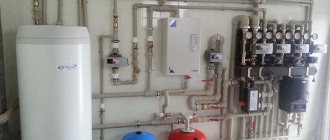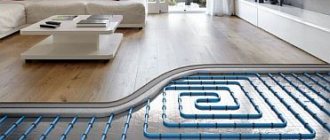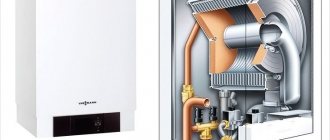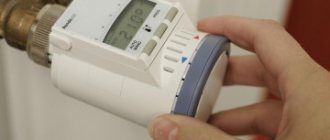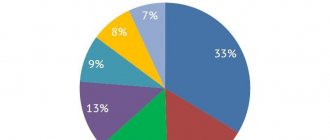the installation of a heat meter in an apartment itself
is not protection against increases in tariffs for consumed resources, but its presence allows you to optimize costs, including through the ability to regulate the temperature in the room. This result is achieved due to the fact that such devices not only serve to account for the consumed coolant, but also provide the consumer with the opportunity to independently regulate the amount of coolant entering the system. In Soviet-built apartments, it is impossible to organize such accounting, due to the peculiarities of the heating systems, but the best option in such cases is to install building-wide heat meters, which also serve for accounting, while the amount of consumed heat resources is divided among all apartments, in proportion to the heated area. But it must be taken into account that in this case, public areas are also taken into account and taken into account: entrances, corridors, etc.
The need to install heat meters in apartments and houses
It should be noted that the law
obliges developers to equip all separate residential premises in houses for rent with individual metering devices. One of the by-laws is Decree of the Government of the Russian Federation No. 1708 of December 28, 2022, according to which changes are made to the rules for the provision of utility services, including those related to heat supply services, to owners and other users of premises in apartment buildings and other residential buildings. According to the resolution, every owner or tenant of a residential premises has the right to install an apartment heat meter, regardless of whether such devices are installed in other apartments. At the same time, the responsibility of management companies (or homeowners associations) is that they must register the heat meter and make charges for consumed heat solely based on the readings of the device.
However, it is imperative to take into account that before proceeding with the selection of a meter and installation of equipment, you must first obtain permission from the service provider (in each specific case, these may be different organizations, but most often it is a management company or a homeowners association). This is followed by:
- prepare design documentation;
- submit it for approval to the supplying organization;
- Next - carry out installation work, after which you must again contact the service provider, who will send a specialist to seal the device.
You should definitely know that, in addition to the heat meter, temperature sensors and connecting fittings are also subject to sealing.
ORDER A SERVICE FROM ACCREDITED COMPANIES
Who has the right to install heat meters
The installation of heat meters must be carried out by a specialized organization that has a license to perform the relevant work, SRO approvals, and certificates. Data about the company must be entered into the Unified State Register of Legal Entities. An important requirement for the contractor is the availability of special equipment and specialists with appropriate training.
GC "N2O-TECHNOLOGIES" fully meets these requirements. We offer the following benefits to clients:
- Installation of only new devices supplied in original packaging.
- Prompt dispatch of installers to any administrative district of Moscow.
- High-quality installation – leaks and malfunctions in the operation of the device are eliminated.
- Providing a guarantee for installed heat meters and work performed. Liability to clients is insured with coverage of 1,000,000 rubles.
How to properly install a heat meter in a house
It should be noted that it is recommended to entrust all work related to the development of the project and installation of equipment to an organization for the installation of heat meters
, whose specialists are sufficiently qualified to carry out such work, and the company itself has the necessary permits and licenses. When installing a heat meter, you can only save money by turning to professionals - attempting to install it yourself or with the help of a familiar technician can result in both financial and time losses. But when choosing an organization, you need to pay attention to whether it has:
- accreditation and registration of the company in the Unified State Register of Legal Entities;
- title documents, certificates, licenses and other permits;
- a complete list of works allowing the company to install a turnkey heat meter;
- metrological and other laboratory equipment;
- the ability to assume warranty obligations.
You should also pay attention to other aspects, namely:
- the ability to provide service during equipment operation;
- the reputation of the company, which you can ask about either from clients, or by looking at reviews of consumers of services;
- efficiency of work.
The general algorithm for cooperation between the customer and the contractor is as follows:
- First, a contract is concluded, on the basis of which the design is prepared, approved, and installed;
- after installation, a work acceptance certificate is drawn up;
- further, a warranty and/or service agreement may be concluded;
- the next step is putting the equipment into operation, which is confirmed by the act;
- sealing (a representative of the heat supply company is invited for this stage of work).
The customer may request from the contractor a copy of the permit for installation work, and he also has the right to receive a technical passport of the heat meter with a quality certificate.
After all the documents are in the possession of the customer - the owner of the premises, he must register them by contacting the heating service provider company.
Types of heat meters
Thermal energy metering devices are classified according to their operating principle. Using this parameter it is possible to install heat meters
the following types:
- Mechanical or tacheometric. The measurement is carried out by rotating an impeller, screw or turbine measuring part, which works in conjunction with a heat meter. These are inexpensive models with easy maintenance.
- Electromagnetic. The operating principle is based on the phenomenon of electromagnetic induction, which allows you to measure coolant flow. With sufficiently high measurement accuracy, these devices are sensitive to the quality of installation, chemical composition and purity of the coolant.
- Ultrasonic. The coolant flow rate is calculated by measuring the speed of ultrasound passing through the liquid flow. They provide high measurement accuracy, but produce significant errors if the coolant is contaminated.
- Vortex. The phenomenon of vortex formation behind an obstacle that bends around the coolant flow is used. Can be installed in heating systems with horizontal and vertical wiring.
- Heat computers. New type of electronic devices. They are not installed on the pipeline, but directly on the radiator. They measure heat consumption with high accuracy using temperature sensors.
Attention!
Our company uses modern heat meters from leading brands. These are devices that provide high measurement accuracy, durability, and can be installed on various types of heating systems. The warranty for installed models ranges from 2 to 4 years, and the calibration interval ranges from 6 to 12 years.
Cost of installation of metering devices: factors influencing the final price
Initially, you should take into account that the cost of installing heat meters in an apartment
includes not only the price of the device itself, but also:
- project development;
- installation work;
- technical support.
In addition, other factors influence the final price of installing a heat meter in an apartment, the main ones being:
- wiring diagram of the heating system in an apartment or house;
- pipe diameter and material;
- accessibility of nodal points for installation;
- difficulty in installing the selected meter model;
- technical features of the building itself in which the equipment is planned to be installed: load on the system, pressure in the pipes and other points;
- the need for additional work.
Also included in the cost of installing a heat meter are the costs of purchasing consumables and additional materials, the list of which is determined individually. As a rule, additionally purchased:
- various types of components: filters, pipes, collet connections, etc.;
- connection kit;
- check valves;
- taps, intended, among other things, for installing sensors and other elements of the metering device.
Taking into account the fact that the installation of equipment for metering thermal energy consumption is a rather complex technical process associated with the need to correctly document all stages of the work, it is not recommended to install metering devices independently, as this will require large financial and time costs. Involving specialists allows you to avoid many mistakes, and in addition, complete the work in the shortest possible time.
What determines the price of a heat meter?
The modern market for heat consumption metering devices is represented by numerous manufacturers. The cost of production is influenced by many factors. Firstly, the technologies and equipment used in production. Secondly, the price will depend on the design features and the method of reading readings.
Cheaper models have a shorter verification period. Tachometer systems will cost 6-10 thousand rubles, but they will require additional purchase of fittings, a magnetic-mechanical filter and shut-off valves. The average cost of vortex heat meters varies within 15 thousand rubles. Its installation will also require the preliminary installation of a filter. What you need to purchase additionally in most cases:
- a mechanical cleaning filter designed to remove solid, insoluble particles, sand, abrasives, and organic impurities from water;
- tee for connecting a temperature sensor, which simplifies the organization of a resource consumption metering unit;
- shut-off valve to shut off the flow of water;
- valve to control the supply of liquid.
The key parameter influencing the final price of the heat meter is the amplitude of the forward-return pressure indicators. There are often models on sale in which this amplitude is very small. This situation is especially common in heating networks of the fuel and energy complex or in municipal boiler houses.
The most economical purchase is an electromagnetic device that can be used for a long time. Its average cost is 15-17 thousand rubles; additional costs will be required for servicing the ODPU. For new buildings, experts from our online store recommend purchasing ultrasonic devices, which will cost 15-50 thousand. It is important to remember that in addition to purchasing the unit and components, you will also have to spend money on project preparation, installation work and commissioning.
The problem of choosing a heat meter model. What factors influence decision making?
An important aspect of cooperation with specialized companies should be considered the opportunity to receive qualified assistance, including in choosing a heat meter model, since the “more expensive is better” principle does not work in this case. When choosing a device, it is important to take into account not only its technical characteristics, but first of all the technical conditions of the existing heating system for operation with which it is planned to install the device.
To install a heating meter
You can use several types of devices that differ not only in appearance, size and brand name, but above all in their operating principle. According to this criterion, heat meters are:
- mechanical;
- ultrasonic;
- electromagnetic and others.
In addition, devices may have additional functions and capabilities. For example, some heat meters are designed to operate in automatic mode with the ability to connect to a single center for data transfer, which greatly simplifies the process of monitoring and accounting for heat resource consumption. Such devices are equipped with special pulse outputs or are capable of supporting the M-bus protocol. In cases where the heat meter is not intended to be integrated with automatic control systems, there is no need to purchase a heat meter with additional functions. Especially considering that, regardless of the type and model of the device, the operation of the heat meter is based on taking into account the consumed coolant and the difference in temperature readings. Based on the data obtained, using the comparison method, the real volume of thermal energy consumption is determined.
When choosing a heat meter model, it is necessary to take into account the nominal diameter of the device (DN), and also take into account the type of wiring in the apartment. The optimal is the horizontal system, which has become the norm when laying pipes in modern houses - in this case, each apartment has a separate entrance (and, accordingly, exit), which makes it easy to organize a heat consumption metering system in a separate living space. In Soviet-built apartments, a fundamentally different wiring method was used - vertical. In this case, the apartment may have several inputs and outputs, which significantly complicates the process of organizing accounting at such facilities. The best option may be to install a common house meter, and it is recommended to organize individual metering using special devices - heat distributors. But we must take into account that in this case it is assumed that such a meter will be installed on each heating radiator.
In systems with vertical wiring, the installation of a heat meter is complicated not only by the need to install them for each radiator, but also for a metrological reason - in some cases it is difficult to achieve a temperature difference of 3 °C between supply and outlet.
Summary
The determining factors for choosing a heat meter model are the individual characteristics of the living space, home and heating system configuration. The financial capabilities of the consumer also play an important role. If you need to purchase a heat meter, you need to act consistently. First find out the type of heating wiring. When pipes run horizontally, you need to find out whether the remote control system is functioning in the house. If it is available, it is also necessary to clarify what output the device should have. If remote metering is not maintained, you need to find out on which pipe the previous apartment heat meter . This circumstance must be taken into account during installation planning. In such a situation, you don’t have to hesitate and buy a universal unit. If the system is vertical, you will have to buy devices approved by Rosstandart.
When choosing a heat meter, we recommend giving preference to an ultrasonic one. The device is unpretentious to the purity of main water. Before purchasing, you need to pay attention to the accompanying documentation and check the date of initial verification in your passport. The longer the device has been with the seller, the sooner it will have to be checked or replaced. Devices with a calibration interval of 6 years will undoubtedly have an advantage.

